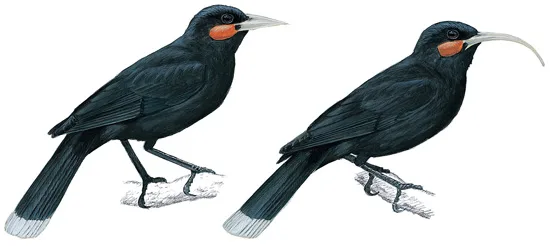
Huia
The story
After the European invasion of New Zealand, the birdlife came under intense scrutiny and no species fascinated ornithologists more than the Huia. This was probably largely due to a unique peculiarity of the Huia’s anatomy. The beak of the male differs markedly from that of the female. At first sight this might not seem of any particular importance but no other known bird species shows a comparable difference: although plumages may vary vastly between the sexes, beaks are always fairly similar. In the case of the Huia, however, the beak of the male is powerful and rather crow-like whereas that of the female is long, slender and down-curved. This difference was so unexpected that when specimens first reached ornithologists they were thought to constitute two separate but related species, the female being given the name acutirostris and the male crassirostris.
What was the reason for this divergence? The answer to this question has to be that pairs co-operated in feeding. If two birds could tap different food sources then the territory that they needed to occupy would be smaller. Perhaps the great wonder is why such a useful-seeming adaptation is not commoner. It could, of course, be argued that the very fact of the Huia’s extinction indicates that the strategy does not really work.
The male Huia could use its chunky beak to break up rotting branches or trunks, leaving the female free to come along behind and use her long, slender bill to probe into the distressed material for insects and their larvae. A favourite food item was, apparently, the huhu, a large plump grub of the nocturnal beetle Prionoplus reticularis; another was the weta (Hemideina megacephala).
As might be expected in pairs of birds that are so dependant on each other, extreme distress was shown by any individual that lost its mate. There are several accounts that detail the behaviour of birds whose mate had been shot. Instead of flying off at the sound of the gunfire, the survivor would stay and search for its downed fellow. Doubtless, this kind of unwariness was one of the prime reasons for the species’ extinction. Probably it fell prey to four-legged mammalian predators as easily as it fell prey to man.
The range of the Huia was always rather restricted. It seems to have occurred only on New Zealand’s North Island – although there are one or two indications that it may have been present at the very north of the South Island. Even on the North Island only certain areas seem to have suited it. The famous chronicler of New Zealand birds Sir Walter Buller commented on the fact that in winter Huias needed to descend from any mountainous territory occupied, in order to avoid the extremes of cold. Probably it was this liking for warmth that prevented Huias from successfully inhabiting the rather cooler South Island.
Largely thanks to the works of Buller, a body of information exists on the lifestyle of this bird. The call was as the name; Huia is simply a phonetic rendering of it. It was described as soft and fluting and altogether haunting. The species laid 2-4 greyish eggs that were marked with brown and purplish spots and blotches, and breeding occurred during the Southern Hemisphere summer, chiefly around the month of November.
There is no doubt that the species’ general demeanour rendered it ripe for extinction, but other factors probably played a part. Chief among these is the fact that large areas of the North Island became cultivated or were given over to grazing, so the woodland that formed the Huia’s natural habitat became ever more fragmented. The last fully accepted sighting of living Huias dates from the year 1907, but it is almost
certain that a few birds lingered on after this date.
The best description of the bird in life comes from the pen of Buller (1887-88): The Huia never leaves the shade of the forest. It moves along the ground, or from tree to tree, with surprising celerity by a series of bounds or jumps. In its flight it never rises, like other birds, above the tree-tops, except in the depths of the woods, when it happens to fly from one high tree to another…They are generally met with in pairs, but sometimes a party of four or more are found consorting together…this species builds its nest in hollow trees, forming it of dry grass, leaves and the withered stems of herbaceous plants, carefully twined together in a circular form, and lined with softer material of a similar kind.
